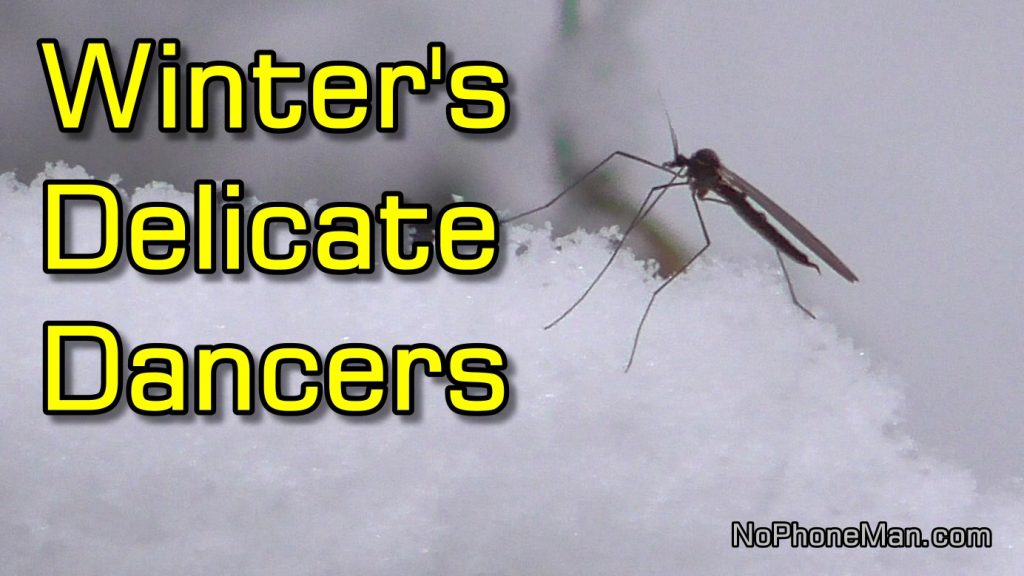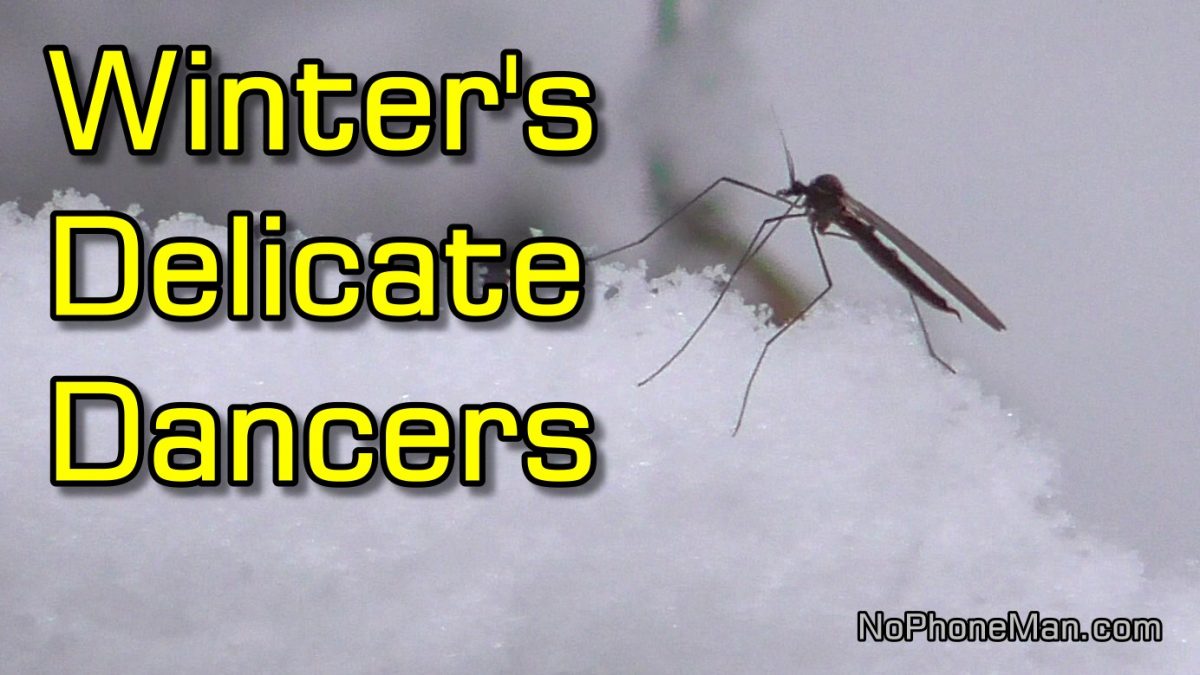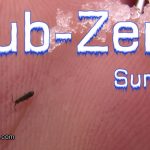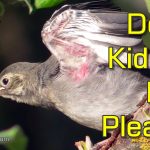
Even though their name suggests that these insects are adapted for life in winter, it still surprises me to see Winter Crane Flies (Trichocera Annulata) flying about in the depths of it. I take regular, every day strolls through the woods – no poop – but even when I go when the outdoor temperatures are way below freezing and the whole countryside is under half a meter of snow, I see Winter Crane Flies flying about.
It’s fascinating because they are such delicate insects, yet somehow they found a way to not only survive, but thrive in sub zero temperatures.
Winter Crane Flies look mighty similar to mosquitoes, but no mosquito would pull off a flight in the middle of winter, when the last thing I’d expect to see are live insects.
Owing to my frequent encounters with Winter Crane Flies during the winter season, I decided to film them and make a video about their life in the snow blanketed environment with little sustenance for any live form. They often offer me great opportunities to film them, other times they move from one spot to another, making it a challenge to track their tiny bodies with a camera.
Granted, so long as they stay close to the snow, I can see them fly despite their small size. But when they fly higher up against the forest canopy or other darker colored background, the chance to see them quickly disappears.
Nevertheless, I put together a video showcasing the life and behavior of Winter Crane Flies smack in the middle of winter, and I also included a little footage and information about the other insect that can be seen flying about in winter – the Winter Moth (Operophtera Brumata). However my observations clearly suggest that Winter Crane Flies are far more resilient, as I see them out and about throughout the entire winter, whereas Winter Moths, even though they still can be encountered on freezing cold days, no longer come out when the temperatures dip real low.
And because I included both Winter Crane Flies and the Winter Moth in the video, I also talk about the difference between the two, especially the fact that Winter Crane Flies, aside from the possibility of being confused with a mosquito and thus trigger others to want to kill them, don’t pose any threats to humans or our crops, wheres the Winter Moth can be incredibly destructive, especially its larvae form, which can cause significant damage to fruit trees for orchard farmers, but also damage various hardwood trees in the forest.
About Winter Crane Flies
Scientifically belonging to the Trichocerca group of insects, Winter Crane Flies are a fascinating group of insects that play a significant role in winter ecosystems. Let’s take closer look at them.
Anatomy and Morphology
- Adults:
- Winter crane flies typically exhibit a slender and delicate appearance.
- They have long, slender legs and wings, resembling other crane fly species.
- The body of an adult crane fly is divided into three main segments: head, thorax, and abdomen.
- Adult crane flies lack mouthparts, and they do not feed during their relatively short adult lifespan.
- Larvae:
- The larvae of winter crane flies are aquatic and often found in freshwater habitats.
- Larvae possess a distinct head capsule and a segmented body.
- They have prolegs along their abdomen, aiding in locomotion in aquatic environments.
- The coloration of larvae can vary but is generally adapted to camouflage with their surroundings.
Life Cycle and Development
- Egg Stage:
- Winter crane flies typically lay their eggs in aquatic environments, such as ponds, streams, or wetland areas.
- The eggs are laid in masses, and their hatching time may vary depending on environmental conditions.
- Larval Stage:
- The larval stage is spent in water, where larvae actively feed on organic matter and microorganisms.
- Development from egg to larva may take several weeks, with variations based on temperature and food availability.
- Larvae play a crucial role in nutrient cycling within aquatic ecosystems.
- Pupal Stage:
- After completing the larval stage, crane fly larvae pupate near the water’s edge.
- Pupation is a transitional stage where the larva transforms into the adult crane fly.
- Pupae are often found in silken cocoons or in the soil.
- Adult Stage:
- Adult winter crane flies emerge from the pupal stage and are characterized by their delicate appearance.
- Adult crane flies have a relatively short lifespan, during which their primary focus is mating.
- Mating behavior and reproductive strategies may vary among different species within the Trichocerca genus.
Ecology
- Habitat:
- Winter crane flies inhabit a range of freshwater ecosystems, including ponds, streams, and wetlands.
- They are particularly adapted to survive in colder conditions, contributing to their prevalence during winter months.
- Role in Ecosystems:
- Larvae play a crucial role in nutrient cycling by consuming organic matter in aquatic environments.
- Adult crane flies contribute to the food web by serving as prey for various predators.
Interactions with Other Organisms
- Predators:
- Larvae and adult winter crane flies are preyed upon by various organisms, including birds, amphibians, and other insects.
- Their role as a food source contributes to the ecological balance in their respective habitats.
- Symbiotic Relationships:
- Winter crane flies may engage in symbiotic relationships with microorganisms in their aquatic environments, influencing nutrient cycling and water quality.
Economic Importance
- Positive Impact:
- Winter crane flies, as part of aquatic ecosystems, contribute to nutrient cycling, maintaining the health of freshwater environments.
- Negative Impact:
- While generally beneficial, large populations of crane fly larvae may cause damage to agricultural crops if their numbers become excessive.
Winter Crane Fly vs. Mosquito: Distinguishing Features
Winter crane flies (Trichocerca) and mosquitoes are both members of the insect order Diptera, but they exhibit distinct differences in their anatomy, behavior, and ecological roles.
Anatomy and Morphology:
- Winter Crane Fly:
- Winter crane flies typically have a slender and delicate appearance, with long legs and wings.
- Adult crane flies lack mouthparts, and they do not feed during their adult stage.
- Larvae of winter crane flies are aquatic and possess prolegs along their abdomen for movement in water.
- Mosquito:
- Mosquitoes have a more robust body compared to crane flies.
- Adult mosquitoes have specialized mouthparts, called proboscis, used for piercing and sucking blood.
- Mosquito larvae are also aquatic but lack the distinctive prolegs found in crane fly larvae.
Life Cycle and Behavior:
- Winter Crane Fly:
- The life cycle of winter crane flies typically involves an egg stage, aquatic larval stage, pupal stage, and a short-lived adult stage.
- Adult crane flies focus on mating and do not feed.
- Mosquito:
- Mosquitoes have a more complex life cycle, involving egg, larva, pupa, and adult stages.
- Female mosquitoes often require a blood meal for egg development, and they can be vectors for diseases like malaria and dengue.
Feeding Habits:
- Winter Crane Fly:
- Adult crane flies do not feed, as they lack functional mouthparts.
- Mosquito:
- Female mosquitoes feed on blood to obtain necessary nutrients for egg development.
- Male mosquitoes and mosquito larvae primarily feed on nectar and other organic matter.
Ecological Roles:
- Winter Crane Fly:
- Winter crane flies play a crucial role in nutrient cycling within aquatic ecosystems.
- They contribute to the food web as prey for various predators.
- Mosquito:
- While mosquitoes also play a role in nutrient cycling, they are notorious for their role as disease vectors.
- Mosquito larvae and adults serve as a food source for various organisms, contributing to ecological balance.
Interactions with Humans:
- Winter Crane Fly:
- Winter crane flies do not pose a direct threat to humans as they do not feed on blood.
- Mosquito:
- Mosquitoes are known for their bites, which can transmit diseases to humans and other animals.
- Mosquito-borne diseases are a significant concern in many parts of the world.
Understanding these differences is essential for both scientific study and public awareness, as it contributes to a better understanding of the ecological roles and potential impacts of these two distinct insect groups. Please don’t kill Winter Crane Flies. They are NOT mosquitoes. They do not bite.
Winter Crane Fly Diet: Exploring Feeding Habits
The diet of winter crane flies (Trichocerca) plays a crucial role in their life cycle and contributes to the overall health of aquatic ecosystems. Unlike some other insects, adult winter crane flies do not feed, relying on energy reserves accumulated during their larval stage. However, the larval stage is marked by active feeding behaviors that impact nutrient cycling in freshwater habitats.
Larval Feeding Habits:
- Organic Matter Consumption:
- Winter crane fly larvae are predominantly detritivores, feeding on decaying organic matter in aquatic environments.
- They play a vital role in breaking down plant material, algae, and other organic debris, contributing to nutrient cycling.
- Microorganism Consumption:
- Larvae also feed on microorganisms such as bacteria, fungi, and small invertebrates present in their aquatic habitat.
- This feeding behavior helps regulate the populations of these microorganisms and influences water quality.
- Contribution to Nutrient Cycling:
- By actively consuming organic matter, winter crane fly larvae contribute to the recycling of nutrients in freshwater ecosystems.
- This process is essential for maintaining the balance of nutrients and supporting the overall health of the aquatic environment.
Adaptations for Aquatic Feeding:
- Prolegs and Locomotion:
- Winter crane fly larvae have specialized prolegs along their abdomen, aiding in movement and providing stability in aquatic environments.
- These adaptations enable larvae to navigate through submerged vegetation and substrate, facilitating efficient foraging.
- Filter-Feeding Mechanisms:
- Some species of winter crane fly larvae may exhibit filter-feeding behaviors, utilizing setae or specialized structures to filter particles from the water.
- This adaptation allows them to capture and consume small particles, including organic detritus and microorganisms.
Seasonal Dynamics:
- Activity Variation:
- The feeding activity of winter crane fly larvae may vary seasonally, influenced by factors such as temperature, water quality, and food availability.
- Larvae are often more active during warmer periods, contributing to increased nutrient cycling during these times.
Impact on Ecosystems:
- Ecological Balance:
- The feeding habits of winter crane fly larvae contribute to the ecological balance of freshwater ecosystems.
- By regulating organic matter and microorganism populations, they indirectly influence the abundance and distribution of other aquatic organisms.
- Food Web Dynamics:
- Winter crane fly larvae, as a food source for various predators, are integral to the aquatic food web.
- Their feeding habits create cascading effects on the abundance and diversity of organisms within their ecosystems.
Understanding the diet of winter crane flies sheds light on their ecological role as contributors to nutrient cycling and highlights their importance in maintaining the health and balance of aquatic environments.
Winter Crane Fly Habitat and Range:
Winter crane flies (Trichocerca) are well-adapted to a variety of freshwater habitats, where they play integral roles in nutrient cycling. Understanding their preferred habitats and geographic distribution provides valuable insights into the ecological dynamics of these fascinating insects.
Preferred Habitats:
- Freshwater Ecosystems:
- Winter crane flies are commonly found in a range of freshwater habitats, including ponds, streams, wetlands, and other aquatic environments.
- They thrive in areas where water is present, contributing to the dynamic ecosystems associated with these habitats.
- Aquatic Vegetation:
- Preferred habitats often include areas with submerged or emergent aquatic vegetation.
- Larvae of winter crane flies may use these vegetation types for shelter, substrate attachment, and as a source of food.
- Temperature Considerations:
- While winter crane flies are adapted to colder conditions, their habitat preferences may be influenced by temperature variations.
- They are often more prevalent in cool to cold environments, especially during winter months.
Geographic Range:
- Global Distribution:
- Winter crane flies have a broad geographic distribution, and various species can be found on different continents.
- Their adaptability to diverse environments contributes to their presence in both temperate and cold regions.
- Northern Hemisphere:
- Many species of winter crane flies are commonly found in the Northern Hemisphere, where they are well-suited to cold climates.
- They may inhabit regions with seasonal temperature fluctuations, including areas with winter frost.
- Altitudinal Range:
- Winter crane flies may be found at various altitudes, ranging from lowland areas to mountainous regions.
- Their ability to thrive in different elevations reflects their ecological versatility.
Microhabitat Selection:
- Substrate Preference:
- Larvae often select specific substrates for pupation, such as soil near the water’s edge or within the aquatic vegetation.
- Microhabitat preferences may vary among species within the Trichocerca genus.
- Depth and Flow:
- Larvae may exhibit preferences for specific water depths and flow conditions.
- The choice of microhabitat can impact their ability to access food resources and avoid predation.
Seasonal Dynamics:
- Overwintering Strategies:
- Winter crane flies are adapted to survive colder conditions and may employ various overwintering strategies.
- Some larvae may remain active in the substrate, while others may enter diapause to endure harsh winter conditions.
- Seasonal Abundance:
- The abundance of winter crane flies may vary seasonally, with peak activity often observed during colder months.
- Understanding seasonal dynamics is crucial for assessing their ecological impact and interactions with other organisms.
Human Impact:<
- Urban and Agricultural Areas:
- Some species of winter crane flies may adapt to human-altered environments, including urban areas and agricultural landscapes.
- Understanding their ability to coexist with human activities is essential for conservation efforts.
In summary, the habitat and range of winter crane flies reflect their adaptability to a variety of freshwater environments. From ponds to mountain streams, these insects contribute to the ecological diversity and health of aquatic ecosystems across different geographic regions.
Winter Crane Fly Identification: Key Features and Species Characteristics
Identifying winter crane flies (Trichocerca) involves examining specific morphological characteristics of both adults and larvae. While individual species within the Trichocerca genus may exhibit variations, certain key features can aid in their accurate identification.
Adult Identification:
- Body Structure:
- Winter crane flies typically have a slender and delicate body structure.
- Adults have three distinct body segments: head, thorax, and abdomen.
- Wings and Legs:
- Long, slender legs and wings are characteristic of adult winter crane flies.
- The wings may have intricate venation patterns, contributing to their delicate appearance.
- Mouthparts:
- Notably, adult winter crane flies lack functional mouthparts.
- Their short adult lifespan is primarily focused on mating, and they do not engage in feeding activities.
- Antennae:
- Antennae of winter crane flies are often long and may have distinctive characteristics, aiding in species differentiation.
- Coloration:
- Adult coloration varies among species and may include shades of brown, gray, or other subdued colors.
- The specific color patterns and markings on the body and wings can be key identification features.
Larval Identification:
- Body Segmentation:
- Larvae of winter crane flies have a segmented body, with a distinct head capsule and abdomen.
- The abdomen often bears prolegs, which assist in movement in aquatic environments.
- Coloration and Size:
- Larval coloration varies, but it is often adapted for camouflage in their specific habitat.
- Size can range depending on the species, and detailed measurements may be necessary for precise identification.
- Mouthparts:
- Larvae possess mouthparts adapted for feeding on detritus, microorganisms, and organic matter in aquatic environments.
- Adaptations for Aquatic Life:
- Specialized adaptations for aquatic life include prolegs for movement and, in some species, structures for filter-feeding.
Species-Specific Characteristics:
- Genitalia Examination:
- For precise identification, examination of genitalia may be necessary, especially in adult specimens.
- Species within the Trichocerca genus may exhibit specific characteristics in male and female genitalia.
- Microscopic Features:
- In some cases, microscopic examination of certain morphological features, such as setae or spines, may be required for accurate species identification.
Identification Guides and Resources:
- Taxonomic Keys:
- Utilizing taxonomic keys specific to winter crane flies can assist in the identification process.
- These keys often guide users through a series of characteristics to narrow down potential species.
- Entomological References:
- Consultation of entomological references and field guides focused on crane flies can provide detailed information on species identification.
Photographic Documentation:
- Photography for Reference:
- Photographing adult specimens, larvae, and key morphological features can be invaluable for identification purposes.
- Clear images of wings, legs, antennae, and other characteristics aid in comparing with existing identification resources.
Identifying winter crane flies requires a combination of observational skills, attention to detail, and often, specialized knowledge. Collaborating with entomologists or utilizing comprehensive identification guides specific to the Trichocerca genus can enhance the accuracy of species identification efforts.
About The Winter Moth (Operophtera Brumata)
The Winter Moth (Operophtera brumata) is a species of moth belonging to the Geometridae family. Commonly found in temperate regions, this insect plays a significant role in forest ecosystems and can have economic implications, particularly due to the damage caused by its larvae to trees.
Anatomy and Morphology
- Adult Moth:
- The adult Winter Moth is relatively small, with a wingspan of around 2.5 to 3.5 centimeters.
- Males are typically light brown, while females are larger and have reduced wings, rendering them flightless.
- Both sexes exhibit feathery antennae, which aid in detecting pheromones released by females.
- Larvae:
- Larvae are caterpillars with a distinctive green color and noticeable prolegs along their body.
- They possess chewing mouthparts, allowing them to feed on leaves.
Life Cycle and Development
- Egg Stage:
- Winter Moths lay eggs on the bark and branches of host trees during late fall or early winter.
- The eggs remain dormant until spring.
- Larval Stage:
- Upon hatching, larvae feed on emerging buds and young leaves.
- Larval development lasts for several weeks, after which they pupate.
- Pupal Stage:
- Pupation occurs in the soil, and adults emerge in late fall or early winter, completing the life cycle.
Ecology
- Habitat:
- Winter Moths are commonly found in deciduous and mixed forests.
- They may also inhabit urban and suburban areas.
- Host Plants:
- Preferred host trees include oak, maple, apple, and other deciduous species.
Interactions with Other Insects and Animals
- Predators:
- Various bird species, such as chickadees and titmice, feed on Winter Moth larvae.
- Parasitoid wasps also play a role in controlling populations.
- Symbiotic Relationships:
- Winter Moths contribute to nutrient cycling when their pupae decompose in the soil.
Impact on Trees and Economic Importance
- Tree Damage:
- The most significant economic impact arises from the larvae’s feeding habits.
- Larvae strip leaves from host trees, potentially causing defoliation.
- Economic Consequences:
- Defoliation can weaken trees, making them susceptible to other stressors.
- In orchards, Winter Moth infestations may lead to reduced fruit production.
Interaction with Humans
- Human Health:
- Winter Moths do not pose direct threats to human health.
- Management Strategies:
- Integrated pest management strategies, including the use of insecticides and biological control agents, are employed to mitigate infestations.
Conclusion
Understanding the Winter Moth’s life cycle, ecology, and interactions is crucial for effective pest management and the preservation of affected ecosystems. As this species continues to impact both natural and cultivated environments, ongoing research is essential to develop sustainable strategies for control and prevention.
Winter Moths as Invasive Species
Winter Moths (Operophtera brumata) have earned a reputation as invasive species due to their introduction and subsequent establishment in regions outside their native range. Several factors contribute to their invasive nature.
- Introduction:
- The Winter Moth is native to Europe but has been introduced to various parts of North America and other regions.
- Introductions are often unintentional, occurring through the transportation of infested plant material, including nursery stock.
- Rapid Spread:
- Once introduced, Winter Moths can spread quickly, facilitated by their ability to reproduce rapidly and their adaptability to diverse habitats.
- Their high reproductive potential allows for population explosions, leading to widespread infestations.
- Lack of Natural Controls:
- In their non-native range, Winter Moths may lack natural predators and diseases that regulate their populations in their native habitats.
- The absence of these controls contributes to unchecked population growth, exacerbating the invasive impact.
- Host Range Expansion:
- Winter Moths are known for their broad host range, feeding on a variety of deciduous trees.
- This adaptability enables them to exploit new environments and expand their range more easily.
- Ecological Disruption:
- The invasive behavior of Winter Moths can disrupt local ecosystems.
- The larvae’s voracious feeding habits can lead to defoliation of host trees, impacting the abundance and diversity of native flora and fauna.
- Economic Consequences:
- The invasion of Winter Moths can have economic repercussions, particularly in agricultural and horticultural settings.
- Damage to trees, ornamental plants, and crops may result in economic losses and increased management costs.
- Human-Mediated Spread:
- Human activities, including the movement of infested plants and materials, contribute significantly to the spread of Winter Moths.
- Awareness and practices to minimize unintentional transport are essential for preventing further invasions.
- Challenges in Control:
- Controlling invasive Winter Moth populations can be challenging due to their adaptability and rapid reproduction.
- Integrated pest management strategies are crucial for effective control, often involving a combination of chemical, biological, and cultural control methods.
Understanding the invasive characteristics of Winter Moths is vital for implementing measures to prevent their introduction, mitigate their impact, and protect ecosystems from the potential consequences of their establishment in new regions. Ongoing research and collaboration are essential for developing and refining strategies to manage and control this invasive species.
Winter Moth Prevention Strategies
Preventing and managing Winter Moth infestations is crucial for minimizing the impact on trees and ecosystems. Various proven and effective strategies can be employed to control the spread of Winter Moths.
- Early Monitoring:
- Regular monitoring of trees for the presence of Winter Moth eggs and larvae allows for early detection.
- Identifying infestations in their initial stages facilitates prompt intervention.
- Pheromone Traps:
- Pheromone traps can be strategically placed to monitor adult male populations.
- These traps aid in tracking the timing of egg-laying and can inform the implementation of control measures.
- Biological Control:
- Introducing natural predators and parasitoids specific to Winter Moths can be an effective biological control strategy.
- Predatory insects, such as parasitic wasps, can help keep Winter Moth populations in check.
- Insecticidal Treatments:
- Targeted application of insecticides during the larval stage can help prevent extensive defoliation.
- Environmentally friendly and selective insecticides can be utilized to minimize non-target effects.
- Cultural Practices:
- Practices such as pruning and proper tree care contribute to the overall health and resilience of host trees.
- Maintaining healthy trees makes them more resistant to Winter Moth infestations.
- Barrier Bands:
- Applying sticky bands around tree trunks creates a physical barrier, preventing the ascent of larvae.
- This method is particularly effective for controlling the crawling larvae as they move up the tree.
- Integrated Pest Management (IPM):
- Implementing an integrated approach that combines various control methods is often the most effective strategy.
- IPM involves the use of multiple techniques, including cultural practices, biological control, and targeted insecticide applications.
- Quarantine Measures:
- Strict quarantine measures can help prevent the unintentional spread of Winter Moth through the movement of infested materials.
- Controlling the transportation of firewood and nursery stock is crucial in limiting the insect’s range.
- Community Involvement:
- Raising awareness within communities about the threat of Winter Moth infestations encourages collective action.
- Engaging the public in monitoring efforts and implementing preventive measures enhances the overall success of prevention strategies.
By combining these prevention strategies, communities and individuals can contribute to the effective management of Winter Moth populations and protect the health of trees in both natural and urban environments. Early detection and proactive measures are key to mitigating the impact of this invasive species.





